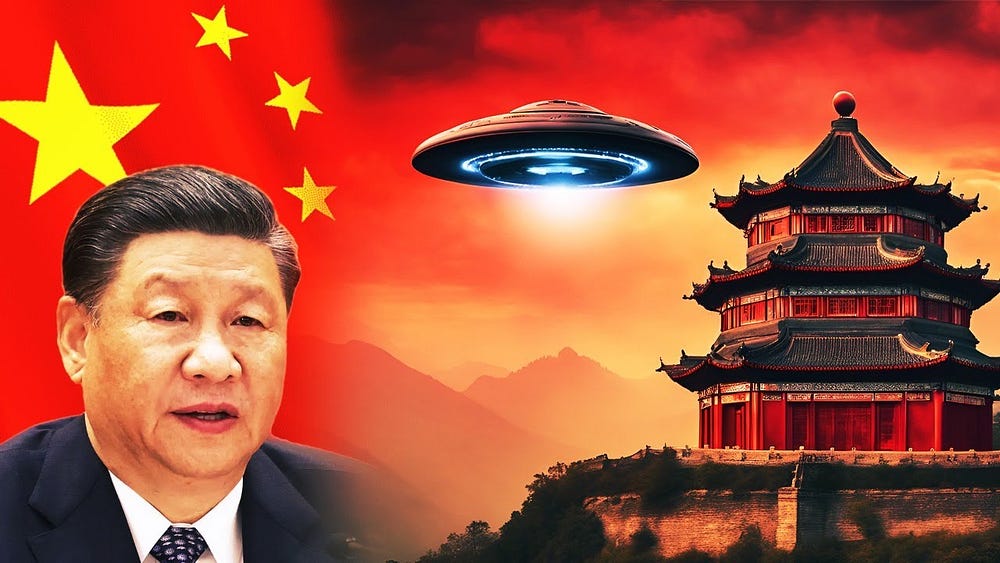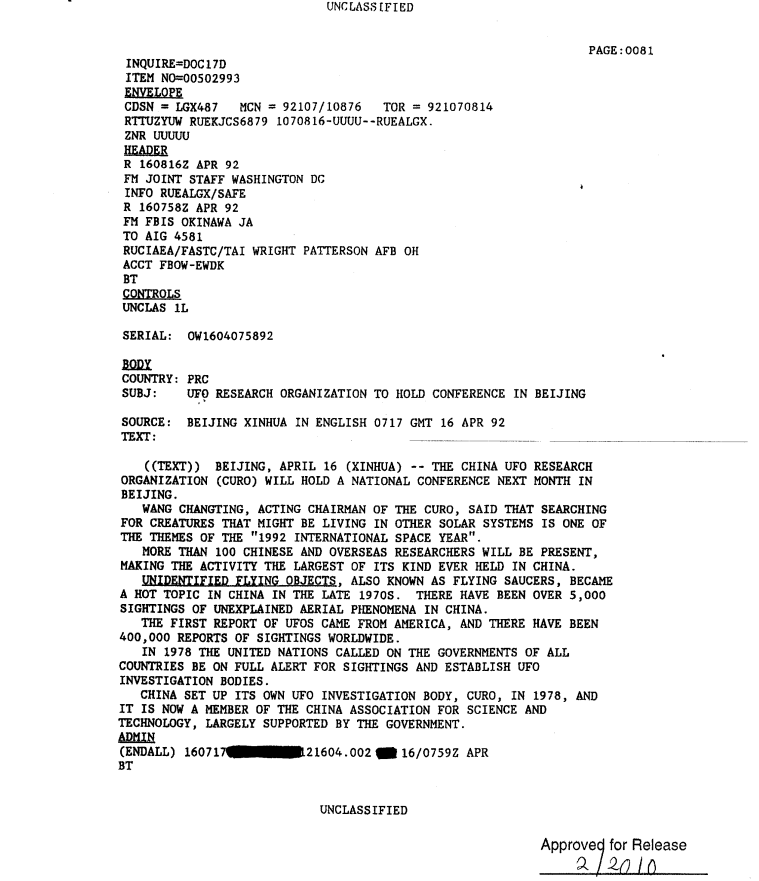
▶️ Watch Chinese Encounters with UFOs and Aliens Video here
The Painting from 1892
On the evening of September 28, 1892, the city of Nanjing had their own UFO sighting that is recorded in a painting. This incident marked one of China’s first-ever illustrated account of a UFO sighting.
The central figure in this historical episode is Wu Youru, a painter whose work during that period captured various facets of Chinese life and culture. On that fateful night, Wu documented an unusual sight in his illustration titled “Soaring Scarlet Flame in the Sky” (赤焰騰空).
The illustration shows a crowd gathered on Zhuque Bridge, located near today’s Laomendong area, all eyes fixed on the night sky. The source of their fascination was a fireball-like object that sparked widespread concern and curiosity.

Soaring Scarlet Flame in the Sky
Wu Youru’s illustration was accompanied by a description that provided a vivid account of the event. At 20:00, a fireball appeared in the southern sky of Nanjing, resembling a gigantic egg and moving slowly from west to east. Its red color stood out against the night sky, though it lacked any shine. Hundreds of civilians jostled for a view on Zhuque Bridge, their gazes locked upwards as the object floated languidly across the sky.
The object lingered long enough to be observed for the duration of a meal before gradually fading into the distance. Speculations abounded, with some suggesting it was a meteor and others a lantern kite. However, the object’s slow movement and the direction it traveled in, against the wind, debunked these theories, leaving the mystery unsolved.
An elderly man’s account added to the intrigue, noting a faint noise accompanying the object’s appearance, likening it to the soft buzz of men darting across the South Gate. This detail, along with the object’s origin from the city’s southern outskirts, only deepened the mystery.
The PLA and UFO Investigations
Fast forward to the 20th century, the People’s Liberation Army (PLA) of the People’s Republic of China, encompassing various service branches, has developed a structured approach to investigating “unidentified air conditions.” This term, echoing the US military’s “unidentified aerial phenomena,” signifies the PLA’s effort to systematically study such sightings. China created their UFO task force back in 1927.
Utilizing a three-tiered system, the PLA gathers data from military radar stations, air force pilots, police, weather stations, and observatories under the Chinese Academy of Sciences. Despite the increasing volume of reports, overwhelming analysts, the PLA’s UFO task force has turned to artificial intelligence to sift through the data efficiently.
China holds National Conference about UFOs in 1992

UFO Encounters in China’s Gobi Desert and Ancient Chronicles
Two significant works, “UFOs over modern China — a survey of the phenomenon” by Wendelle Stevens and Paul Dong (1983), and “From The Record — UFO Sightings in the Ancient Chinese History Books” by Taiwanese researcher Kai-Chi Chang (1991), provide compelling cases and stories that were published in Chinese journals shedding light on the UFO mystery.

A Close Encounter in the Gobi Desert, April 1968
Gu Ying, then a 17-year-old interpreter for the New China Agency and a member of a military construction regiment, recounted his experience in the book UFOs over modern China — a survey of the phenomenon. Amidst a significant irrigation project in northern China, Gu and his battalion encountered an odd sighting one evening in mid-April.
A comrade’s alarm drew their attention to a great disc of light, trailing flames as it descended towards the Gobi sands. This luminous red-orange object, with an apparent diameter of 3 meters, landed less than a kilometer from their position. Its sudden ascent and disappearance into the night sky upon the approach of motorcycle troops dispatched by the regiment’s headquarters left a lasting impression on the witnesses. The incident, marked by a seared cross on the ground, was initially interpreted in political terms, suspected to be reconnaissance by northern adversaries. However, the peculiar nature of the landing and take-off suggested something far beyond conventional understanding.
Ancient Chronicles of UFOs
Kai-Chi Chang’s 1991 publication delves into the ancient records, cataloging 741 UFO incidents recorded between 139 BC and 1918 AD. These accounts range from brief notes, such as the appearance of “two moons” in the night sky in 32 BC, to more detailed observations. One such detailed account from April 13, 905 AD, during the Tang dynasty, describes a large star-like object, resembling a grain measuring container, that appeared in the sky. Exhibiting behaviors no meteor could, such as pausing mid-air, changing direction, and serpentinizing while emitting tall flames, this phenomenon defied conventional explanations, suggesting an encounter with an unidentified flying object.

Chinese Fighter Jet vs. UFO, 1998
On October 19, 1998, an unusual radar blip emerged over Changzhou, captivating the attention of military personnel in Hebei province, China. This anomaly, detected simultaneously by four military installations, hovered above a military aviation school, defying conventional identification. Colonel Li, the base’s commanding officer, swiftly deployed a Jianjiao 6 fighter jet, piloting into the unknown.

The incident, witnessed by over 140 individuals, initially appeared as a diminutive star, expanding as though descending. The object, described as a mushroom-capped dome atop a flat base, emitted a kaleidoscope of rotating lights, mesmerizing onlookers. The Jianjiao 6 crew, drawing parallels to sci-fi spacecraft, engaged in a high-stakes game of cat and mouse. Despite closing in, the UFO showcased superior maneuverability, evading capture with astonishing agility. Ground control, cautious, denied the pilot’s request to open fire, opting for observation over aggression. The pursuit was abandoned as fuel reserves dwindled, leaving the unidentified entity to vanish into the night sky.
UFO Sightings Disrupt Air Traffic, 2010
The mystery deepened in September 2010 when a UFO sighting prompted the temporary shutdown of an airport in Inner Mongolia. This event marked the eighth report of its kind since June of that same year, stirring public and media speculation. Erratic bright lights observed by air traffic controllers led to flight diversions, echoing a similar disruption at Xiaoshan Airport in Hangzhou, July as well. Despite official denials and attributions to military exercises, these incidents fueled debates on the true nature of the sightings.

The February 2023 Phenomenon: Beyond Spy Balloons
In February 2023, the narrative took a compelling turn as residents of Qiqihar, Heilongjiang Province, reported seeing UFOs of their own. According to TASS, the Russian News Agency, bright lights adorned the sky, only to fade into obscurity. Local meteorologists and air defense officials could not provide any explanations for the phenomena. This incident was part of a series of UFO sightings across various locations, including a previous sighting over the coastal province of Shandong in eastern China. During the same period, the United States and Canada reported shooting down three high-altitude unidentified objects.
Notably, a similar occurrence in Heilongjiang Province in 2014 involved metallic orbs descending into localities, sparking extensive investigations.
▶️Watch the Chinese Encounters with UFOs and Aliens Video Here
Access all of Cristina Gomez’ links — click here

Comments & Upvotes